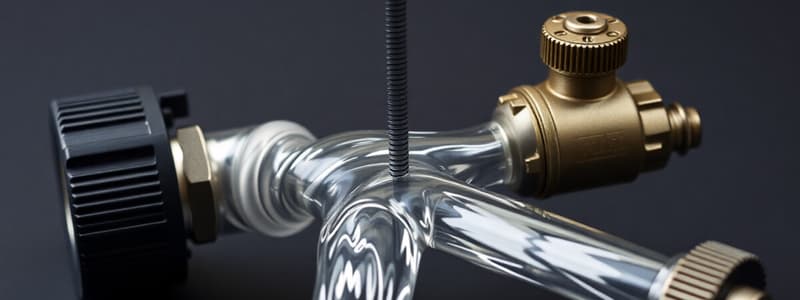Podcast
Questions and Answers
What is the significance of maintaining material balance in fluid flow?
What is the significance of maintaining material balance in fluid flow?
- It ensures that energy is conserved within the system.
- It confirms that product in equals product out. (correct)
- It helps to maintain the mechanical integrity of pipes.
- It determines the temperature of the fluid accurately.
Which method is commonly used to determine flow rates in plants?
Which method is commonly used to determine flow rates in plants?
- Flow meter direct measurement.
- Pressure gauge monitoring.
- Orifice plate in conjunction with delta p transmitter. (correct)
- Ultrasonic flow measurement.
Which of the following measures is the most accurate way to express flow?
Which of the following measures is the most accurate way to express flow?
- Mass in pounds. (correct)
- Velocity in cubic feet per second.
- Flow in barrels.
- Volumetric flow in gallons.
According to Bernoulli's Principle, what happens to fluid pressure when velocity increases?
According to Bernoulli's Principle, what happens to fluid pressure when velocity increases?
In fluid dynamics, what characterizes turbulent flow as opposed to laminar flow?
In fluid dynamics, what characterizes turbulent flow as opposed to laminar flow?
How is gas flow typically expressed in fluid flow measurements?
How is gas flow typically expressed in fluid flow measurements?
What role does the differential pressure across the orifice plate play in fluid flow?
What role does the differential pressure across the orifice plate play in fluid flow?
Flashcards are hidden until you start studying
Study Notes
Flow
- The quantity of fluid that moves through a pipeline.
- Important for material balance: ensuring the amount of product entering a system equals the amount exiting.
- Can be expressed in terms of velocity, volume, or mass.
Velocity
- Usually expressed in cubic feet per second.
- Not the most common method.
Volume
- Expressed in gallons or barrels.
Mass
- Expressed in pounds, offering the most accurate representation of flow.
Bernoulli's Principle
- Developed by Swiss Mathematician and Physicist Daniel Bernoulli.
- States that as fluid velocity increases, pressure within the fluid decreases.
- Illustrated when blocking a garden hose; the water velocity increases, and the pressure decreases.
Measuring Flow Rates
- Orifice Plate: The most common method used in plants.
- Delta P Transmitter: Used in conjunction with the orifice plate.
- High Side of the Transmitter: Connected upstream of the orifice plate.
- Low Side of the Transmitter: Connected downstream of the orifice plate.
- Pressure Gradient: Flow always moves from high pressure to low pressure.
- Differential Pressure: The larger the differential pressure across the orifice plate, the greater the flow rate.
Flow Rates by Substance
- Gas Flow Rates: Expressed in SCF (standard cubic feet).
- Fluid Flow Rates: Expressed in GPM (gallons per minute), GPH (gallons per hour), GPD (gallons per day), BPM (barrels per minute), BPH (barrels per hour), and BPD (barrels per day).
- Steam Flows: Expressed as mass flow in pounds.
Flow Types
- Laminar Flow: Smooth, parallel flow.
- Turbulent Flow: Characterized by irregular, chaotic movement.
- Causes of Turbulent Flow: Increased fluid velocity, changes in pipe diameter, and obstructions within the pipe.
Studying That Suits You
Use AI to generate personalized quizzes and flashcards to suit your learning preferences.




